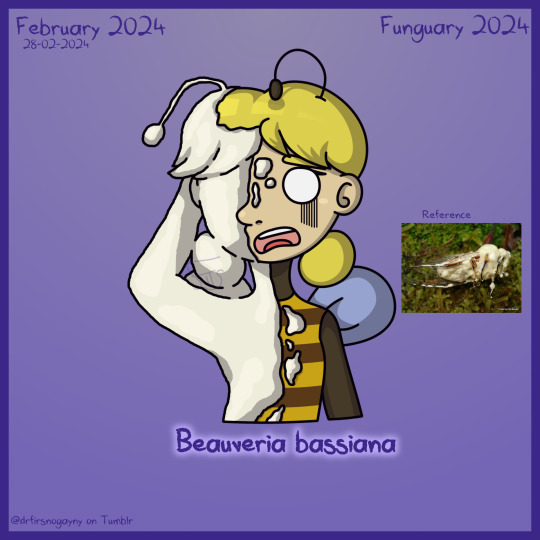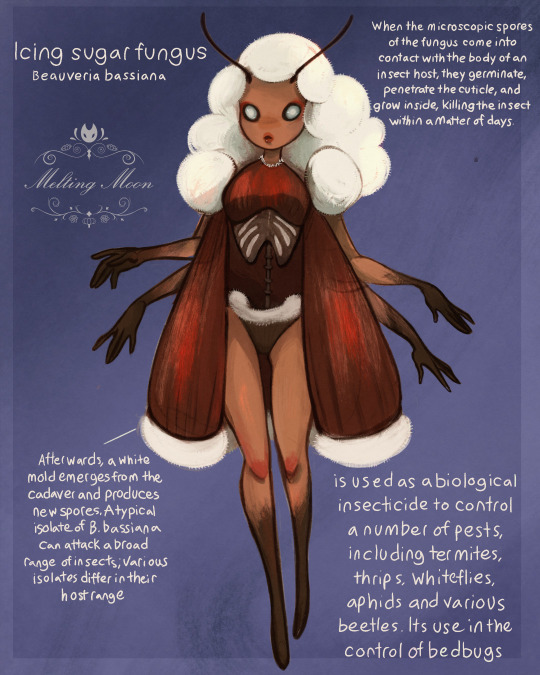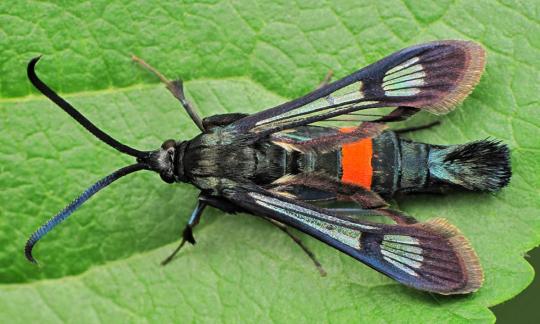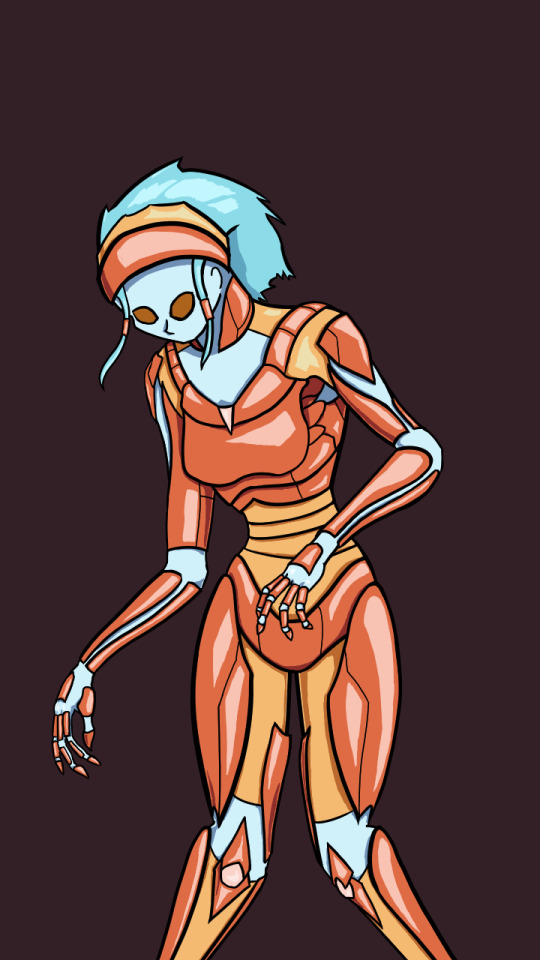#Beauveria Bassiana
Explore tagged Tumblr posts
Text

Funguary Feb 28 - Cryptic Icing Sugar Fungus - Beauveria bassiana
The group of entomopathogenic fungi known as icing sugar fungus also affect True Fae. In this case, it is one of the few ways that the fae can become undead.
#original art#funguary#funguary2024#funguary 2024#mushroom#fungus#fungi#parasite#cryptic#icing sugar#icing sugar fungus#beauveria bassiana#undead
25 notes
·
View notes
Text
Funguary 2024 Day 28
🪬 Week 4: Cryptic 🐝 Beauveria bassiana aka Icing sugar fungus

She/her
Poor bee girl who wandered into the wrong territory. Let's hope this white stuff washes off easily and doesn't cause any harm. Does it wash off?
Other arts:
🧢 Mycena Subcyanocephala
🪸 Lilac Coral Fungus
🦃 Turkey Tail
☁️ Cystolepiota
🏮 Filoboletus Manipularis
🪽 Angel Wings
🧽 Penicillin
👹 Satan's Bolete
🌳 Silver Leaf Fungus
🗡️ Destroying Angel
🪺 Birds Nest Fungus
🧟 Dead Man's Fingers
👒 Lilac Bonnet
🩸 Bleeding Tooth
🪮 Black Velvet
🍜 Enoki
🍘 Dotted Stem Bolete
🌧️ Inky Cap
☕ Black Trumpet
🧤 Amethyst Deceiver
🍚 Puffball
💧 Dewdrop Bonnet
🫂 Mycorrhizal Network
🎭 False Blusher
🐕 Stinkhorn
🌵 Prototaxites
🪬 Blue Coprinopsis
🐝 Icing Sugar Fingus 🍄
💋 Magic Mushroom
Organizer: @/feefal
Pic on ref (I just noticed that there was a cicada in the photo, even though I was drawing a bee. In any case, the main image here is a fungi, not an insect)
#artist on tumblr#humanization#art challenge#funguary#funguary 2024#funguary2024#beauveria bassiana#icing sugar fungus
11 notes
·
View notes
Text
How Trichoderma asperellum Boosts Plant Immunity and Fights Off Pathogens
In the pursuit of sustainable agricultural solutions, Trichoderma asperellum has become an essential tool for farmers and gardeners alike. This soil-dwelling fungus, known for its ability to promote plant health and fend off harmful pathogens, plays a crucial role in natural plant defense and soil fertility. As a biological agent, Trichoderma asperellum not only enhances plant immunity but also improves overall soil quality, making it a vital component in sustainable farming practices.
Colonizing Plant Roots for Protection
The primary strength of Trichoderma asperellum lies in its ability to colonize plant roots. Once established, the fungus forms a protective barrier that shields plants from disease-causing organisms, particularly soil-borne pathogens like Fusarium, Rhizoctonia, and Phytophthora. These pathogens can cause significant damage to crops, resulting in issues like root rot, damping-off, and other plant diseases. By occupying the root zone, Trichoderma asperellum effectively prevents these pathogens from gaining a foothold, reducing the likelihood of infection.
This root colonization also gives Trichoderma asperellum an advantage over chemical treatments. While fungicides often kill pathogens on contact, they do not provide the long-term protection that Trichoderma asperellum offers. Once the fungus is established in the soil, it continues to protect the plant roots throughout the growing season, creating a stable and healthy growing environment. This protective function makes Trichoderma asperellum an invaluable ally in crop protection.
Inducing Systemic Resistance in Plants
One of the most remarkable benefits of Trichoderma asperellum is its ability to induce systemic resistance in plants. This process, known as Induced Systemic Resistance (ISR), occurs when the fungus colonizes the root zone and triggers the plant’s immune system. In response, the plant activates various defense mechanisms, making it more resistant to both biotic (disease-causing organisms) and abiotic (environmental) stressors.
ISR provides plants with a heightened ability to withstand a range of challenges, from fungal infections to drought conditions. By stimulating the plant’s immune responses, Trichoderma asperellum enhances the plant’s natural defenses, allowing it to better cope with adverse environmental factors and pathogen attacks. This induced resistance also means that crops can thrive in less-than-ideal growing conditions, leading to improved yields and more resilient plants.
Enhancing Nutrient Availability and Soil Structure
Beyond its protective functions, Trichoderma asperellum also plays a key role in improving soil health. One of its major contributions is its ability to break down organic matter in the soil, releasing essential nutrients that plants need for growth. Nutrients such as nitrogen, phosphorus, and potassium are made more available to plants through the action of this beneficial fungus, leading to stronger and more vigorous crops.
In addition to nutrient cycling, Trichoderma asperellum enhances the soil’s ability to retain moisture. By improving soil structure, it helps increase water retention, ensuring that plants have access to adequate moisture even during dry periods. Healthier root systems develop as a result, which in turn leads to improved overall plant health and productivity. This ability to support water retention and soil fertility makes Trichoderma asperellum an invaluable tool in regions with limited water resources or poor soil conditions.
A Sustainable Solution for Disease Control
One of the greatest advantages of using Trichoderma asperellum is its role as a natural and sustainable alternative to chemical fungicides. In conventional agriculture, farmers often rely on synthetic chemicals to manage plant diseases, but these treatments can have long-term negative effects on soil health, biodiversity, and the environment. Overuse of fungicides can lead to the development of resistant pathogens, making disease control increasingly difficult over time.
In contrast, Trichoderma asperellum works as a biological control agent that supports healthy soil ecosystems while managing disease pressure. It offers long-term protection without the harmful side effects of chemical treatments. Furthermore, the fungus does not contribute to the development of resistant pathogen strains, making it a more sustainable option for disease control in the long run.
By reducing the need for synthetic inputs, Trichoderma asperellum supports more environmentally friendly farming practices. Its use promotes healthier soils, stronger crops, and more resilient ecosystems, all of which are essential for sustainable agricultural systems. Farmers and gardeners who adopt Trichoderma asperellum as part of their crop management strategies are not only improving their immediate crop performance but also contributing to the long-term health of their soil and environment.
Benefits for Farmers and Gardeners
Farmers and gardeners who incorporate Trichoderma asperellum into their agricultural practices can expect a variety of benefits, including:
Enhanced Disease Resistance: With Trichoderma asperellum colonizing the root zone and inducing systemic resistance, crops become more resistant to both soil-borne pathogens and environmental stressors. This leads to healthier plants and reduced disease pressure.
Improved Nutrient Availability: By breaking down organic matter in the soil, Trichoderma asperellum releases nutrients that are essential for plant growth. This increased nutrient availability supports faster and more robust crop development.
Better Water Retention: The fungus improves soil structure, enhancing the soil's capacity to retain moisture. This helps crops withstand dry conditions and reduces the need for frequent watering.
Sustainable Disease Control: Trichoderma asperellum offers a natural alternative to chemical fungicides, reducing the reliance on synthetic inputs and minimizing the risk of environmental damage. Its use promotes long-term soil health and biodiversity.
Stronger Root Systems: The presence of Trichoderma asperellum in the root zone encourages healthy root development, which in turn allows plants to absorb nutrients and water more efficiently. This results in stronger, more resilient crops.
Conclusion
Trichoderma asperellum is a powerful biological agent that plays a critical role in enhancing plant immunity, promoting soil health, and protecting crops from harmful pathogens. Its ability to colonize plant roots, induce systemic resistance, and improve nutrient availability makes it a valuable tool for both farmers and gardeners seeking sustainable, eco-friendly solutions to disease control and plant health management.
By incorporating Trichoderma asperellum into crop management practices, farmers can enjoy healthier plants, improved yields, and a reduction in disease pressure, all while contributing to the overall sustainability of their agricultural systems. This beneficial fungus not only supports immediate crop performance but also fosters long-term soil health, making it an essential component of sustainable agriculture.
0 notes
Text
Cuando Fallout: New Vegas predijo The Last of Us
Cuando Fallout: New Vegas predijo The Last of Us
Comentaba el otro día que uno de los aspectos que más he disfrutado siempre de la saga Fallout es el de encontrarte con un lugar en el mapa por casualidad, descubrir que tiene una historia propia y sumergirme en esta para llegar a comprender el estado actual de la zona. Es muy común llegar a un pueblo abandonado y encontrarte con cadáveres cuya condición te indica la causa de su muerte (bien por…

View On WordPress
0 notes
Text
Beyond Pests: Peptech's Breakthroughs in Sustainable Farming with Beauveria Bassiana Biopesticides
Peptech Biosciences Ltd pioneers innovative biopesticide solutions by harnessing the natural power of Beauveria bassiana, a fungus renowned for its efficacy in pest management. This biopesticide offers targeted control across a broad spectrum of insect pests, aligning with Peptech Bio’s commitment to sustainable and eco-friendly agriculture. Integrated into holistic pest management strategies, Beauveria bassiana from Peptech Bio ensures a well-rounded approach to pest control while prioritizing safety for humans, animals, and beneficial organisms. The company’s diverse commercial formulations, including sprays and dusts, exemplify convenience and effectiveness in application. With a focus on continuous research and development, Peptech Bio aims to maximize the efficacy of Beauveria bassiana, contributing to a future of sustainable agriculture empowered by natural solutions.

#Peptech Biosciences#Beauveria Bassiana#biopesticides#sustainable agriculture#pest management#innovative solutions
0 notes
Text
The global beauveria bassiana market size was significantly robust in 2020 and is expected to register a steady revenue CAGR over the forecast period.
0 notes
Text
COCOA’S BITTER ENEMY: UNDERSTANDING THE COCOA SWOLLEN SHOOT VIRUS AND ITS MANAGEMENT

Cocoa, also known as the cocoa bean, is a tropical crop primarily cultivated for its seeds, which are utilized in the production of cocoa powder and chocolate. However, cocoa production faces a significant constraint in the form of Cocoa Swollen Shoot Virus Disease (CSSVD), which affects cocoa trees. This devastating disease results in stunted growth, yellowing of leaves, and the swelling of stems in cocoa trees. CSSV is transmitted by various species of mealybugs, tiny insects that feed on plant sap, and it can infect cocoa plants at any stage of development.
To understand deeper about the cocoa swollen shoot virus and its management, we invite you to explore our latest blog post by clicking on the link below: https://www.peptechbio.com/cocoas-bitter-enemy-understanding-the-cocoa-swollen-shoot-virus-and-its-management/
#Cocoa Swollen Shoot Virus#CSSV#Azadirachtin 0.3%#Azadirachtin#Beauveria bassiana#Azadirachtin biopesticide#Beauveria bassiana biopesticide
0 notes
Note
oh!! the joys of being seen!!! a small detail i want to talk about is that entomopathogenic fungi are sometimes used purposely as biopesticides, which i find interesting and kind of cool :"3
that is very cool !!
so, when entomopathogenic fungi are used to control plant diseases as well as some pests & weeds, it's called a mycopesticide. :-)
the two most common (AKA commercially used / sold) mycopesticides are trichoderma sp. & beauveria bassiana.
there are some great benefits to mycopesticides (& reasons why they're better than chemical pesticides) :
pretty much or completely non-toxic to the environment, which is a huge step in front of chemical pesticides.
it's self-replicating & therefore not too expensive to manufacture & buy.
it can be used to target local pests if you collect it from native or local stock :-)
yeah, it's pretty cool !!
#i'd love to say more but i'm having a pain flare :-(#this is sm fun to talk about !!#|#• askbox replies: •#(ask : copper sands)#[beauveria bassiana]#||#fungi#fungus#mushroom#mycology#cottagecore#mushrooms#earth#nature#biology#science#special#interest#autism#myco#mycopesticides#pesticides#parasites#entomopathogenic#bugs#insects
24 notes
·
View notes
Text



Funguary day 26 icing sugar fungus ⠀⠀⠀⠀⠀⠀⠀⠀⠀ Playing catch-up with Funguary prompts. Here’s Beauveria bassiana, nature’s dainty assassin, Inspired by the way this fungus envelops its host, I envisioned it as a couture garment with a life of its own.🍄✨
#artists on tumblr#themeltingmoonart#artists of tumblr#digital art#my art#my artwork#mushrooms#funguary#fungi#funguary 2024
184 notes
·
View notes
Text
Moth of the Week
Red-Belted Clearwing
Synanthedon myopaeformis

Image Source
The red-belted clearwing is a part of the family Sesiidae. It was first described in 1789 by Moritz Balthasar Borkhausen as Sphinx myopaeformis. This was later changed to Synanthedon myopaeformis. This moth is called the red-belted clearwing in Europe, the apple clearwing moth in North America, and the apple borer. This is due to their tendency to damage their host apple trees. It is considered a pest in Europe.
They may be confused with the large red-belted clearwing and the red-tipped clearwing.
Description This moth has a thin, dark blue, segmented body. The body is hairless aside from a bushy tail at the end of the abdomen. They are noticeable due to a bright red-orange band on one of the segments of the abdomen. The wings are clear with a dark outline and veins and a fringe on the outer margin (outer edge). The wings help distinguish the red-belted clearwing from the large red-belted and red-tipped clearwings as the wings have no red-orange markings.
Wingspan Range: 1.8 - 2.8 cm (≈0.71 - 1.1 in)
Diet and Habitat This species eats mainly apple, specifically Crab Apple (Malus sylvestris), as well as Pear (Pryus communis), Hawthorn (Crateagus monogyna), Almond (Prunus dulcis), Rowan (Sorbus aucuparia), apricots, cherries, mountain ash, peaches, plums, and quince. In Canada, adult moths have been attracted to the flowers of the snowy milkweed.
They can be found natively in Europe, North Africa, and Asia Minor. This species was noticed to North America and first detected in Canada in 2005. They inhabit well established orchards and gardens, hedgerows, open woodland, and mature scrub.
Mating Adults emerge from their cocoons in early summer and on flight from May to August, this is presumably their mating season. Females can lay up to 250 eggs, usually singly in the cracks or damaged areas of the trunk and branches they are hosting in. Females attract males with pheromones released from glands. A 2010 study found that 3,13-octadecadienyl acetate is the primary sex hormone.
Predators The larvae of this moth are preyed on by parasites, fungi, and bacteria. The main parasite of red-belted clearwing larvae is Liotryphan crassiseta. Other parasites are Nematodes, Steinernema sp. The fungi Beauveria bassiana and Metarhizium brunneum are common causes of death in larvae as well as the bacteria Bacillus thuringiensis.
Fun Fact
The adult red-belted clearwings are significantly less active on cold days compared to warm days.
In 2014, Judd and Eby found that S. myopaeformis does not discriminate between yellow, green and white or between purple, blue, red, and black. This suggests that they are dichromatic, meaning they can perceive mainly two colors. This affected traps set to catch this species as they acted differently depending on the light reflected.
As this species is considered a pest to apple trees, people have attempted to control the population. This has been tried with pheromone/mating disruption, pheromone laced traps, other chemical traps, the use of predators/enemies, and the covering of apple tree trunks in oil.
(Source: Wikipedia [1][2][3], Butterfly Conservation, Michigan State University)
#libraryofmoths#animals#bugs#facts#insects#moth#lepidoptera#mothoftheweek#sesiidae#red-belted clearwing#Synanthedon myopaeformis#apple clearwing#apple borer#very late post#sorry for the absence
55 notes
·
View notes
Text

The penultimate funguary: Icing Sugar Fungus. Beauveria Bassiana is a parasitic fungus that kills insects, and as such is sometimes used as an insecticide
#my art#digital art#oc#clip studio paint#funguary#funguary2024#funguary 2024#tw eye horror#tw body horror
9 notes
·
View notes
Text
Trichoderma harzianum: The Go-To Biofungicide for Protecting Your Crops Naturally
In the realm of sustainable agriculture, Trichoderma harzianum has gained significant recognition as a powerful biofungicide. Known for its remarkable ability to suppress harmful pathogens and promote plant growth, this fungus is widely used by farmers and gardeners alike. For those seeking eco-friendly, yet effective, crop protection methods, Trichoderma harzianum stands out as an invaluable tool. Its natural mechanisms not only control plant diseases but also contribute to healthier, more resilient crops, making it a key player in the shift toward more sustainable farming practices.
How Trichoderma harzianum Works: The Battle Against Pathogens
At the core of Trichoderma harzianum’s effectiveness is its antagonistic behavior against pathogenic fungi. Harmful fungi such as Botrytis, Fusarium, and Sclerotinia are common culprits behind soil-borne diseases that can wreak havoc on crops. These pathogens can cause root rot, damping-off, and other serious plant diseases that result in significant yield losses. Trichoderma harzianum, however, takes a proactive approach by colonizing the root zone of plants, creating a protective barrier that prevents harmful fungi from establishing themselves.
Once Trichoderma harzianum occupies the root zone, it engages in a form of biological warfare. The fungus releases a variety of enzymes, including chitinases and glucanases, which degrade the cell walls of pathogenic fungi. By breaking down these cell walls, Trichoderma harzianum effectively neutralizes the threat posed by disease-causing fungi. This action not only stops the spread of infections but also helps maintain the overall health of the soil ecosystem.
In addition to its enzyme secretion, Trichoderma harzianum produces secondary metabolites that have antimicrobial properties. These compounds further inhibit the growth of harmful microbes, creating a healthier growing environment for crops. The combination of enzyme activity and antimicrobial compounds makes Trichoderma harzianum a highly efficient biofungicide, capable of controlling a broad spectrum of plant pathogens.
Promoting Plant Growth and Resilience
One of the most significant advantages of using Trichoderma harzianum is its dual action in both disease suppression and plant growth promotion. While it actively protects plants from soil-borne diseases, it simultaneously enhances plant health by improving nutrient uptake. The colonization of the root zone by Trichoderma harzianum stimulates root growth, leading to more robust and extensive root systems. This, in turn, allows plants to access water and nutrients more efficiently, resulting in healthier, more vigorous crops.
Moreover, Trichoderma harzianum plays a crucial role in improving soil health. Its presence enhances the availability of essential nutrients such as nitrogen and phosphorus, which are critical for plant growth. The fungus helps break down organic matter in the soil, releasing nutrients that plants can readily absorb. This improved nutrient availability promotes faster growth and better yields, while also ensuring that plants are better equipped to withstand environmental stresses, such as drought or poor soil conditions.
The plant growth-promoting properties of Trichoderma harzianum extend beyond nutrient uptake. It has been shown to induce systemic resistance in plants, making them more resistant to a variety of biotic and abiotic stresses. By enhancing the plant’s natural defense mechanisms, Trichoderma harzianum contributes to a more resilient crop, capable of thriving even in challenging conditions.
A Sustainable Solution for Farmers
For both organic and conventional farmers, Trichoderma harzianum represents a sustainable solution for managing crop diseases. The use of chemical fungicides has long been the standard approach to controlling plant pathogens, but these chemicals can have negative long-term effects on soil health and biodiversity. Over time, the repeated use of chemical fungicides can degrade soil structure, reduce microbial diversity, and contribute to the development of resistant strains of pathogens.
In contrast, Trichoderma harzianum is a natural solution that not only controls disease but also improves soil health over the long term. Its use reduces the reliance on chemical fungicides, thereby minimizing the negative environmental impacts associated with synthetic inputs. Furthermore, because Trichoderma harzianum is a biological control agent, it does not contribute to the development of resistant pathogen strains. This makes it a more sustainable and durable solution for disease management.
Farmers who incorporate Trichoderma harzianum into their crop protection strategies benefit from improved crop yields, reduced disease pressure, and healthier soils. Its compatibility with other biofertilizers and organic treatments further enhances its versatility as a tool in integrated pest management (IPM) systems. By combining Trichoderma harzianum with other sustainable practices, farmers can create more resilient and productive farming systems that are better equipped to handle the challenges of modern agriculture.
Conclusion
Trichoderma harzianum has firmly established itself as a go-to biofungicide for protecting crops naturally. Its ability to suppress harmful pathogens while promoting plant growth makes it an indispensable tool for both organic and conventional farmers. By colonizing the root zone and releasing enzymes that break down the cell walls of pathogenic fungi, Trichoderma harzianum provides effective disease control without the need for harmful chemicals.
In addition to its role in disease suppression, Trichoderma harzianum enhances plant growth by improving nutrient uptake and stimulating root development, resulting in healthier, more resilient crops. Its contribution to soil health further solidifies its place in sustainable agriculture, as it offers a long-term solution to improving soil quality and promoting ecological balance.
For farmers looking to adopt eco-friendly practices without compromising on crop protection, Trichoderma harzianum is a natural and effective choice. Its widespread use in integrated pest management systems and sustainable farming underscores its value as a cornerstone of modern agricultural practices. By harnessing the power of Trichoderma harzianum, farmers can ensure healthier crops, higher yields, and a more sustainable future for agriculture.
0 notes
Text

One of the drawings meant for Funguary, but was delayed to to various circumstances. I already had a sketch, and I didn't want it to go to waste, so I figured I may as well finish it, deadlines be damned.
Based on the Beauveria Bassiana.
#artists on tublr#digitalart#kritaart#funguary#digital sketch#characterart#funguary 2024#digital drawing#personification
8 notes
·
View notes
Text


Day 11 of : Icing sugar fungus (or beauveria bassiana)
Today we come to my last drawing for this year's challenge!
This mushroom reminded me of a white fur coat, so I played with that idea.I was also inspired by one of the insects that can be affected by the fungus, the apple borer, to design the character (even if I did not completely respect the colors of the butterfly).
Anyway, I'm really happy to finish with this drawing, and I think it's one of my favorites of the ones I've done.



4 notes
·
View notes
Text

Funguary day 28: icing sugar fungus! A new host of occupants for a long neglected skeleton they’re finally putting to use. Based on the Beauveria bassiana (photo below)

Photo credit to Alan Rockefeller on iNaturalist via Wikimedia Commons
3 notes
·
View notes